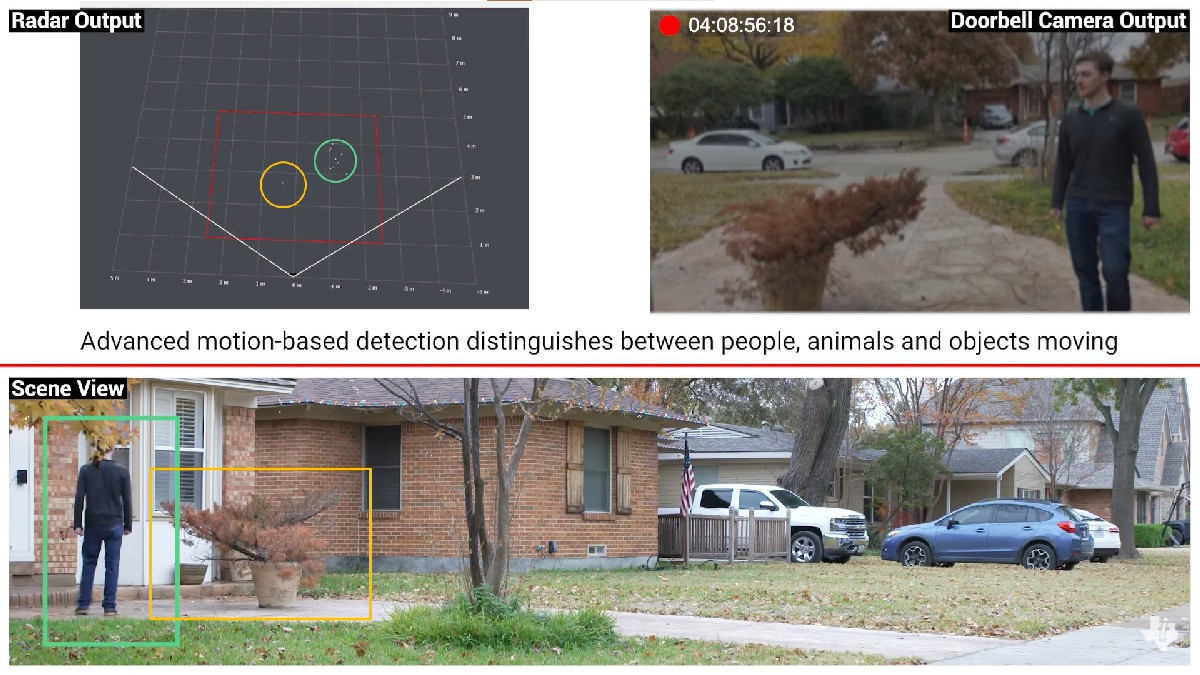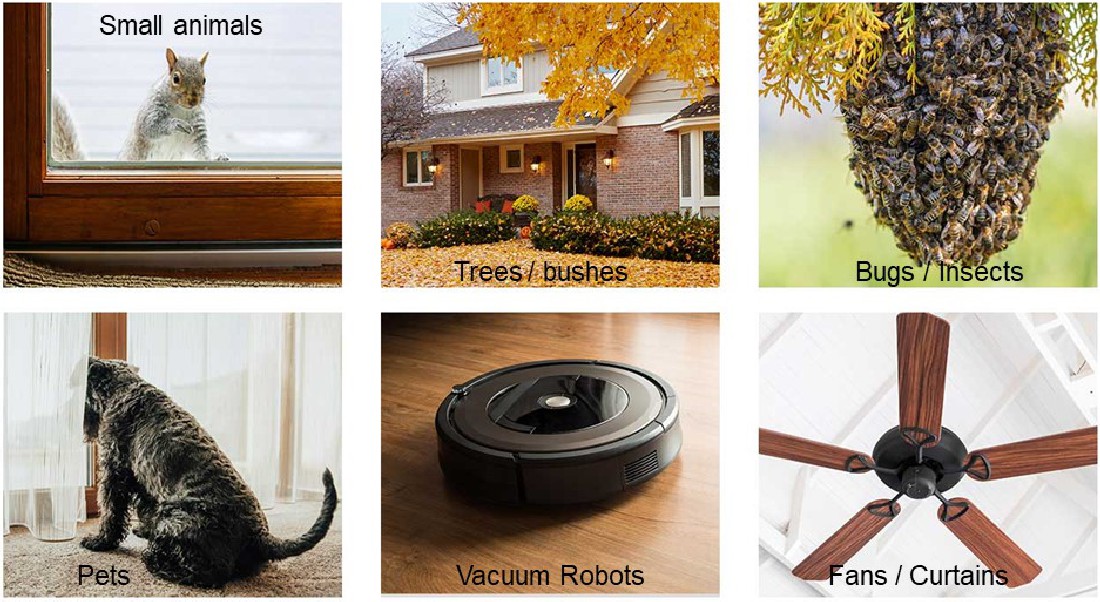SWRA818 May 2024 IWR6843 , IWR6843AOP , IWRL6432 , IWRL6432AOP
Have you ever been alerted by a video doorbell that someone is at the door, only to realize that the alert is caused by the wind blowing the bushes (Figure 1: Reducing False Detections)? This notification is known as a false positive detection - an erroneous detection suggesting a person or motion of interest is present when, in fact it is not. Have you ever had to shut off your surveillance camera notifications because there is a bee hive or wasps’ nest near the camera and the flurry of activity sets off the alarm? False positive. Have you ever worked late in the office and the lights shut off on you due to limited motion although you are still working in the area? This lack of notification is known as a false negative detection - the notion that something of interest is not present nor moving when, in fact the target is present or moving. Have you ever tricked a motion sensor by walking very slowly through a room? This lack of detection is a false negative.
There are several IoT products in the market that use occupancy sensing, or motion detection features (or both) to provide an improved user experience to customers and start a sequence of actions that bring that product to life. Surveillance systems rely on the presence of detection features to sound alerts on potential intruders or security threats. In a residential context, video doorbells use presence detection to notify homeowners that there are visitors at the door, flood lights use presence detection to determine when to illuminate an area based on presence or absence of potential intruders. Other indoor products like appliances, lights, TVs, and more can use motion detection to take an action and improve the user experience. For example, motion detectors are used in conference rooms and office spaces to turn on the lights or keep the lights on for workers in the area. Automation based on presence is an appreciated convenience… when the automation works as expected. However, often what started out as a convenience turns into a nuisance and automated detection gets turned off. The reason these conveniences become nuisances is due to false positive and false negative detections by the sensor.
The issue of false detections from occupancy detection or motion detection systems is a huge problem (Figure 2: Sources of False Detections) regardless of the source and is discussed on many internet forums. A Google search on “how to reduce false positive detections in motion detection systems” returns hundreds of tips, tricks, discussion forums, videos, and so forth. The issue impacts confidence in the motion detection system, dulls senses due to many false notifications, and drains resources. The problem also drains power which is especially problematic for battery-powered systems. The most common sensing technologies used for presence and motion detection are passive infrared sensors (PIR) and vision-based sensors (for example, cameras). These technologies each have positive attributes yet both have many disadvantages particularly relating to false positive and false negative detections. For example, PIR sensors have low sensitivity to motion, cannot handle micro motions, and are unable to identify the source of, or location of, that motion. Due to a dependence on temperature, the sensor performs poorly in outdoor environments at higher temperatures. Cameras are invasive and perform poorly with shadowing, occultation, and sometimes in bright light. Some of the capabilities that make these types of sensors an excellent choice for some applications are the very reason why the sensors are prone to false positive and false negative detections. Therefore, since the most common sensing technologies are part of the problem then there must be an alternative solution. The answer is to use a 60GHz mmWave radar sensor like the IWRL6432AOP (antenna on package) to augment or replace the vision-based, PIR, or another motion-based sensor. mmWave radar sensors enjoy some of the advantages of other sensor types, have additional advantages that are unique to mmWave and do not have some of the less desirable drawbacks versus other sensor types.

Figure 1 Reducing False Detections
mmWave radar is an RF based sensing modality that uses the presence or lack of motion to determine occupancy by bouncing RF waves off of the targets in an area of interest. The reflected wave contains range (distance), velocity (speed + directionality), and angle (location coordinates) information about the targets. This information is then used in several ways to identify the motion (or lack thereof). mmWave radar sensors are uniquely capable of measuring even the most minute movements. For example, the micro motions humans make while breathing or fidgeting can be seen by the IWRL6432AOP. Small head movements and motion from typing can also be easily observed with this sensor. The recognition of these micro motions is what is used by applications to reduce false negative detection. Whereas now almost any motion can be observed by the IWRL6432AOP device.
The IWRL6432AOP also helps reduce false positive detections. Engineers can use one or multiple filtering methods (Table 1) to better assess the observed motion and determine which actions to take or take no action at all. In the case of the bees swarming near to the camera causing an unwanted notification, a IWRL6432AOP-based surveillance system can use a range filter to tell the system to ignore any movement that is within a certain distance from the sensor. The mmWave radar sensor assesses all motion and provides the exact distance of the movement from the sensor to apply the range filter. Additionally, a radar-based occupancy sensor can use the Doppler motion signature from the targets in motion to classify the target as human or non-human (trees or bushes, fans, small animals) and determine if the movement is wanted or unwanted.

Figure 2 Sources of False Detections
 |
Integrated 60GHz radar sensors like IWRL6432AOP provide a high level of intelligence to end users due to on-chip processing and decision-making capability within the integrated circuit (IC) which is a huge advantage versus other sensing modalities. The IWRL6432AOP includes multiple deep sleep modes which allows the device to go into power saving mode when not processing and thus enabling battery operated applications. The radar IC is configurable thus allowing developers to detect in 1D, 2D, or 3D modes of operations to cater to diverging use cases providing a greater degree of freedom and confidence in results.
In summary, the need for devices to get smarter grows. There is an increased reliance on the sensor in the system to provide more information or context about the surroundings. This presents a greater opportunity for false detections and a greater need for the IWRL6432 radar sensor. TI mmWave radar sensors including the new IWRL6432AOP is the best solution for reducing false positive and false negative detections among radar sensors.
Additional Resources
- Download these technical white papers:
- Read the Low Power mmWave Radar Solution Enables New Functionality in Battery Powered Proximity Sensing Products application brief
- See TI's portfolio of industrial mmWave sensors
- Learn more in the TI Developer Zone
- Download the Video Doorbell example project from the TI Developer Zone
- See how TI's IWRL6432 family of radar sensors can be used in personal electronics or industrial applications
- Order the IWRL6432AOPEVM evaluation module